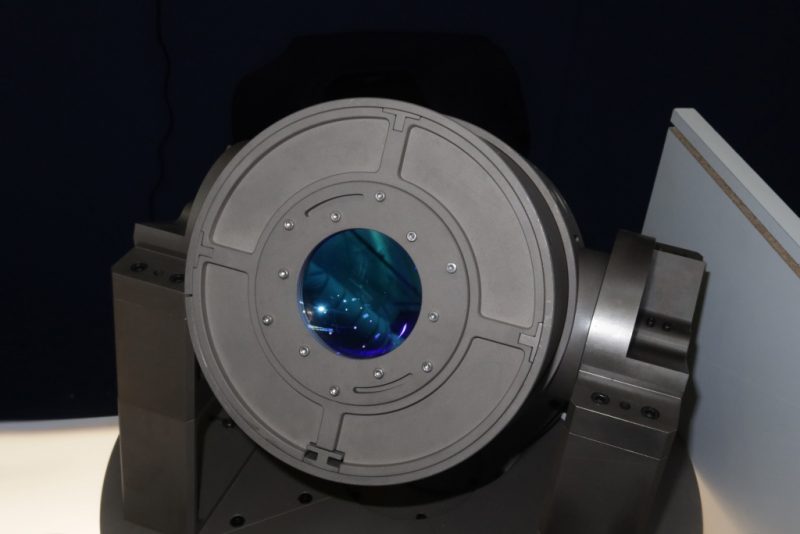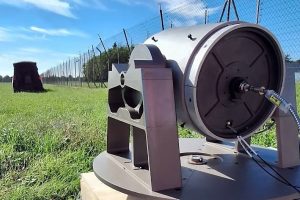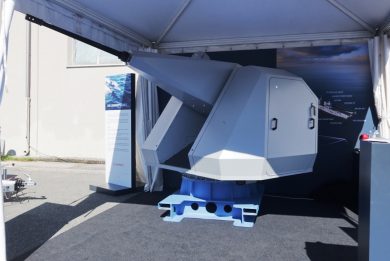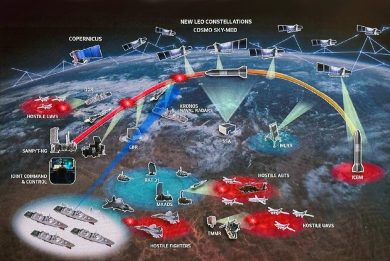Seafuture 2025 – Tethered UAVs without tether, courtesy SunCubes
At the La Spezia exhibition an Italian start-up, SunCubes, exhibited an optical system that provides wireless reliable power and data transfer at distance, untethering UAVs being one of the many applications
Transmitting power and data without any physical link would considerably increase the freedom of unmanned air vehicles (UAVs) that operate in the vicinity of a platform, providing eyes in the sky thus considerably increasing situational awareness.
This is already done with tethered drones, which fly ahead of a vehicle providing a video feed of what the crew will find some moments later, a considerable plus from a safety standpoint. The tether remains however a limiting factor, as it has a relatively short reach, usually between 50 and 100 metres, which with a 16 g/m cable linear mass means 1.6 kg for 100 metres cable and can be used only under a certain vehicle speed and a certain wind speed.
SunCubes started developing laser-based power and data transfer for space applications, then reverted to land, and has now developed a product capable to transmit power and data at a few hundred metres to a static object, but further developments are ongoing to increase power and distance and to allow power and data connection with mobile objects.
At Seafuture the start-up exhibited its SunCubes Light, also known as SCL-15W-D10, the latter definition showing the amount of power that can be transferred, 15 W, and the data throughput, 10 Mbit/s. This system is designed for static applications and is based on a Class 2 laser operating in the near-infrared spectrum, in the 950 to 1,050 nm band. The SunCubes Light is made of two main components, one is the transmitting base unit installed, the second being the receiving client unit installed on the receiving system. Asked about the mass of the latter system, EDR On-Line was told that the energy density of the proposed system is higher than that of a battery, a key issue especially when dealing with flying objects.
The base unit comes in the form of a cylinder with a diameter of around 300 mm and a length of approximately 550 mm. Being a system for static use, targeting and alignment is manual. Declared power transfer distance is up to 1,000 metres, 15 W being received at this end in optimal conditions. This solution might well be used to power up and to maintain the link with sensors distributed along a security perimeter, allowing setting it up the very quickly without using cables. EDR On-Line understood that the power received by the target system is around 10-20% of the SuCubes Light power consumption. A first power loss happens between the energy source and the laser emitter, slightly over 50%, the remaining loss being between the laser emitter and the receiver, which depends very much on attenuation due to meteorological issues, as well as on the distance. The SCL-15W-D10 is at TRL7, according to company representatives.
EDR On-Line understood that in 2023 some early tests were conducted at 50 metres distance in cooperation with Movyon, a centre of excellence for research and innovation for the Autostrade per l’Italia Group, the major Italian motorway company, the SunCubes Light being definitely a duall-use product. The following year further tests were done at Leonardo premises in Venegono Superiore, where training aircraft are produced; here the system demonstrator was successfully tried at 600 metres distance.
The following challenge for SunCubes is to increase distance and to cope with mobile objects, which will allow working with UAVs. The company is already working on the SunCubes Lucy, SCLY-100W, the acronym showing that this time the system is dedicated only to power transfer. It also shows a much higher power at the receiving end, the entire system still based on a Class 2 laser operating in the same bandwidth of the Light. In optimal conditions the range will be 3,000 metres. Aimed at powering UAVs, the targeting and alignment functions will be automatic, the system tracking the drone in order to keep the alignment between the laser source and the receiving element; the tracking system is being developed in-house by SunCubes. According to the company, the receiver has an energetic density greater than a battery, therefore the mass balance on the UAV will be favourable; the company will maintain a backup-battery on board the drone to ensure a 5-minute endurance, should the line-of-sight link be missed. SunCubes currently considering the SCLY-100W at TRL 4. Beside UAVs, the company is also proposing the system for unmanned maritime surface vessels, hence its presence at Seafuture. In perspective the SunCubes Lucy might also integrate the data transfer capability.
In June 2025 SunCubes obtained a Eur 1 million financing from Cassa Depositi e Prestiti, a state-owned financial group that promotes growth and employment, and supports innovation. This should allow the company to speed up the development process of its longer-range system.
Photos courtesy SunCubes and P. Valpolini





